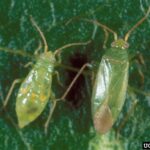Plant Bug
Leaf Feeding Insects & Mites
Plant bugs, also known as true bugs, are a large and diverse group of insects that feed on plants. They are characterized by their piercing-sucking mouthparts and a triangular scutellum, a plate-like structure, located on their thorax. Plant bugs belong to the Hemiptera order, which includes other insect groups such as aphids, cicadas, and stinkbugs.
Plant bugs can cause significant damage to crops and ornamental plants. They feed by inserting their mouthparts into plant tissue and extracting the sap, which can lead to wilting, stunted growth, and reduced yields. Some plant bugs also spread plant diseases, such as mosaic virus, which can further harm the plant.
There are many different species of plant bugs, and their appearance and behavior can vary widely. Some are brightly colored and active during the day, while others are dull-colored and nocturnal. Some plant bugs are highly mobile and can fly, while others are sluggish and crawl slowly on the plant.
Plant bugs can be managed through a combination of cultural and chemical control methods. Cultural control methods include maintaining healthy plants, promoting good air circulation, and removing infested plant parts. Chemical control methods include the use of insecticides, such as pyrethroids and neonicotinoids. It's important to choose the appropriate insecticide based on the type of plant bug, the stage of its life cycle, and the type of plant being treated.
In conclusion, plant bugs are a diverse group of insects that can cause significant damage to crops and ornamental plants. Effective management of plant bugs requires a combination of cultural and chemical control methods and an understanding of the specific biology of the pest.



